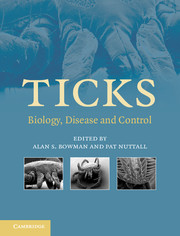Book contents
- Frontmatter
- Contents
- List of contributors
- Preface
- 1 Systematics and evolution of ticks with a list of valid genus and species names
- 2 The impact of tick ecology on pathogen transmission dynamics
- 3 Tick salivary glands: the physiology of tick water balance and their role in pathogen trafficking and transmission
- 4 Tick saliva: from pharmacology and biochemistry to transcriptome analysis and functional genomics
- 5 Tick toxins: perspectives on paralysis and other forms of toxicoses caused by ticks
- 6 Tick lectins and fibrinogen-related proteins
- 7 Endocrinology of tick development and reproduction
- 8 Factors that determine sperm precedence in ticks, spiders and insects: a comparative study
- 9 Tick immunobiology
- 10 Saliva-assisted transmission of tick-borne pathogens
- 11 Lyme borreliosis in Europe and North America
- 12 Viruses transmitted by ticks
- 13 Babesiosis of cattle
- 14 Theileria: life cycle stages associated with the ixodid tick vector
- 15 Characterization of the tick–pathogen–host interface of the tick-borne rickettsia Anaplasma marginale
- 16 Emerging and emergent tick-borne infections
- 17 Analysing and predicting the occurrence of ticks and tick-borne diseases using GIS
- 18 Acaricides for controlling ticks on cattle and the problem of acaricide resistance
- 19 Anti-tick vaccines
- 20 Anti-tick biological control agents: assessment and future perspectives
- 21 Pheromones and other semiochemicals of ticks and their use in tick control
- Index
- References
2 - The impact of tick ecology on pathogen transmission dynamics
Published online by Cambridge University Press: 21 August 2009
- Frontmatter
- Contents
- List of contributors
- Preface
- 1 Systematics and evolution of ticks with a list of valid genus and species names
- 2 The impact of tick ecology on pathogen transmission dynamics
- 3 Tick salivary glands: the physiology of tick water balance and their role in pathogen trafficking and transmission
- 4 Tick saliva: from pharmacology and biochemistry to transcriptome analysis and functional genomics
- 5 Tick toxins: perspectives on paralysis and other forms of toxicoses caused by ticks
- 6 Tick lectins and fibrinogen-related proteins
- 7 Endocrinology of tick development and reproduction
- 8 Factors that determine sperm precedence in ticks, spiders and insects: a comparative study
- 9 Tick immunobiology
- 10 Saliva-assisted transmission of tick-borne pathogens
- 11 Lyme borreliosis in Europe and North America
- 12 Viruses transmitted by ticks
- 13 Babesiosis of cattle
- 14 Theileria: life cycle stages associated with the ixodid tick vector
- 15 Characterization of the tick–pathogen–host interface of the tick-borne rickettsia Anaplasma marginale
- 16 Emerging and emergent tick-borne infections
- 17 Analysing and predicting the occurrence of ticks and tick-borne diseases using GIS
- 18 Acaricides for controlling ticks on cattle and the problem of acaricide resistance
- 19 Anti-tick vaccines
- 20 Anti-tick biological control agents: assessment and future perspectives
- 21 Pheromones and other semiochemicals of ticks and their use in tick control
- Index
- References
Summary
INTRODUCTION: THE IMPACT OF TICK ECOLOGY ON PATHOGEN TRANSMISSION DYNAMICS
The ecology of ticks, the outcome of their interactions with their natural environment, is fundamental to the spatial and temporal variation in the risk of infection by tick-borne pathogens. Due to the biology of ticks as blood-feeding parasites, their physical environment includes the host itself. This biotic environment reacts to the tick's presence in both the short and the long term in ways that the abiotic environment cannot do, imposing physiological, population and evolutionary pressures on ticks. Ticks, however, are only intermittent parasites, spending the greater part of their life cycle free within their habitat where they are at the mercy of abiotic factors such as habitat structure and climate. They take only one (ixodid ticks) or a few (argasid ticks) very large blood meals per life stage, as larvae, nymphs and adults, then develop to the next stage, which takes weeks, months or even years, depending on the ambient temperature. This inter-stadial period is usually passed off-host, although the relatively few two- and one-host ticks (e.g. Hyalomma anatolicum excavatum and Rhipicephalus (Boophilus) microplus, respectively) remain on the host for one or both of the inter-stadial periods. For simplicity, and because generally less is known about the ecology of argasid ticks, what follows will refer almost exclusively to ixodid ticks.
- Type
- Chapter
- Information
- TicksBiology, Disease and Control, pp. 40 - 72Publisher: Cambridge University PressPrint publication year: 2008
References
- 28
- Cited by

